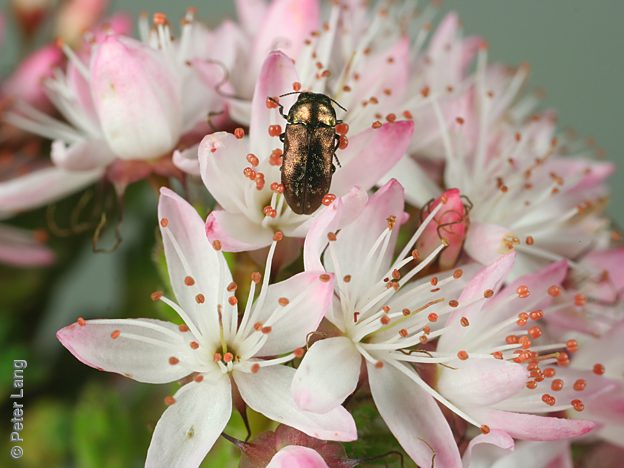
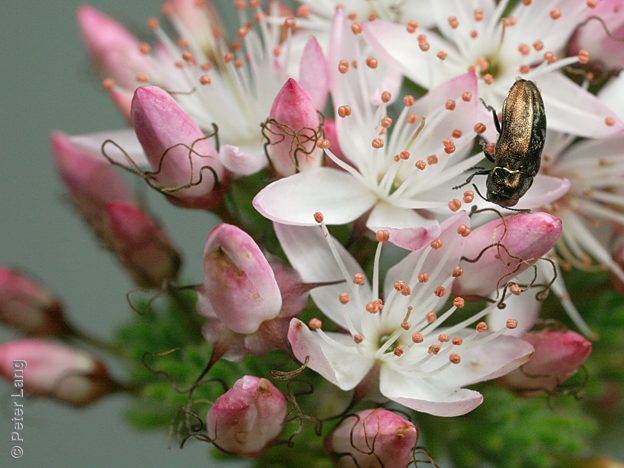
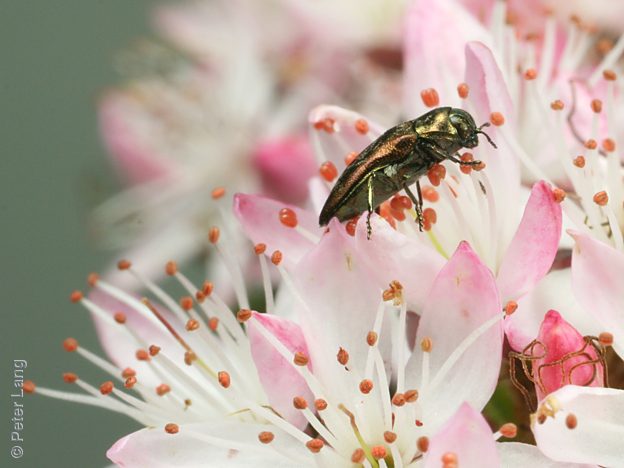
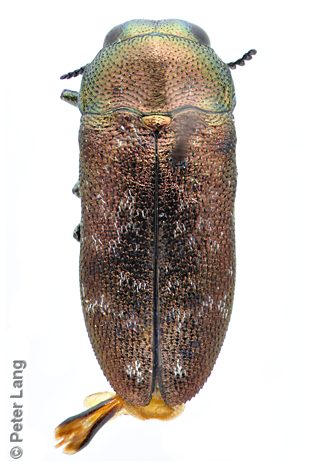
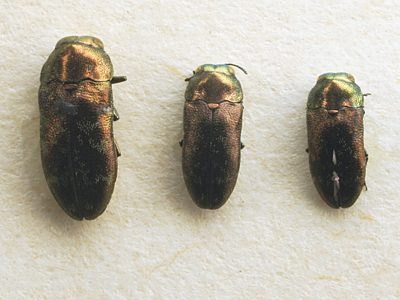
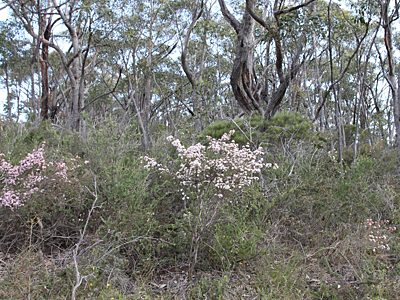
Actual
size¹:
size¹:
3.8 mm
×
1.5 mm
×
1.5 mm






| male | female | |||||
|---|---|---|---|---|---|---|
| L1 | 3.6 | 2.6 – 4.35 | n = 26 | 3.9 | 3.1 – 4.6 | n = 22 |
| L2 | 3.6 | 2.6 – 4.3 | n = 19 | 3.8 | 3.1 – 4.55 | n = 17 |
| W | 1.5 | 1.1 – 1.8 | n = 26 | 1.6 | 1.25 – 1.9 | n = 22 |
| Legend | L1 | length from clypeus/frons to elytral apex (mean, range, sample size) |
| L2 | length from anterior of edge of eyes to elytral apex | |
| W | maximum width with elytra fully closed |
The smallest of the SA Diphucrania species, with bronze to greenish colouration and weak scale-hair patches.
Allied to Diphucrania viridipurpurea, a WA species which has identical genitalia according to Barker (quoted by Niehuis 2001). The holotype of D. minutissima is from Adelaide.
| Legend | P.J.Lang collection vouchered records | |
| other private collection or museum specimens, or sightings |
|
|
|
|
|
|
|
|
|
|
|
|
|
||||||||||||||||||||||||||||||||||||||||||||||||
|
|
|
|
|
|
|
|
|
|
|
|
|
||||||||||||||||||||||||||||||||||||||||||||||||
| Jul | Aug | Sep | Oct | Nov | Dec | Jan | Feb | Mar | Apr | May | Jun |
| Legend | live emerged adults, count > median value of 11 per quarter month | |
| live emerged adults, count <= median value of 11 | ||
| live non-emerged adults only, for that quarter month | ||
12 | number of active beetles for that quarter month |
| beetles | sites | SA regions¹ | family | position on host plant | |||||
| Calytrix tetragona | 71 | 14 | FR, NL, MU, SL, SE | M | |||||
| Leptospermum myrsinoides | 7 | 4 | SL, SE | M | |||||
| Calytrix involucrata | 5 | 1 | EP | M | |||||
| Leptospermum coriaceum | 5 | 5 | EP, SE | M | |||||
| Leptospermum sp. | 5 | 1 | SL | M | |||||
| Homoranthus wilhelmii | 3 | 1 | EP | M | |||||
| Hysterobaeckea behrii | 3 | 2 | MU, SE | M | |||||
| Banksia marginata | 2 | 1 | SL | P | |||||
| Dillwynia sericea | 2 | 1 | SL | F | |||||
| Allocasuarina muelleriana ssp. muelleriana | 1 | 1 | SL | C | |||||
| Dillwynia hispida | 1 | 1 | SE | F | |||||
| Eucalyptus incrassata | 1 | 1 | SE | M | |||||
| Leptospermum continentale | 1 | 1 | SL | M |
| Legend | beetles | count of beetles collected from, or sighted on, host plant taxon |
| sites | count of major sites (unique 10 km grid cells +/- some distinct approximate localities) | |
| Plant names in green are hyperlinked to a matching host species page with plant photos. | ||
| Code | beetles | % | host plant taxa | |
| M | Myrtaceae | 101 | 94% | 8 |
| F | Fabaceae | 3 | 3% | 2 |
| P | Proteaceae | 2 | 2% | 1 |
| C | Casuarinaceae | 1 | 1% | 1 |
| position | beetles | sites | ||
| on flower(s) | 30 | 7 | ||
| on flowering plant | 59 | 15 | ||
| on foliage or non-flowering plant | 1 | 1 | ||
| on plant (unspecified) | 16 | 5 | ||
| other | ||||
| on stems | 1 | 1 | ||
| colour | beetles | sites | SA regions¹ | |
| orange | 1 | 1 | SE |
Unlike the majority of Diphucrania species which are leaf-eating beetles found on foliage, adults of D. minutissima are usually found feeding in flowers of the Myrtle family (Myrtaceae) and mostly commonly in those of the Fringe-myrtles Calytrix.
| ¹ Legend | regions | SA State Herbarium regions (map) EA: Eastern, EP: Eyre Peninsula, FR: Flinders Ranges, GT: Gairdner-Torrens, KI: Kangaroo Island, LE: Lake Eyre, MU: Murray, NL: Northern Lofty, NU: Nullarbor, NW: North-Western, SE: South-Eastern, SL: Southern Lofty, YP: Yorke Peninsula |
| size | The ellipse is the correct size when printed, indicative on a desktop screen, and likely to be wrong on a mobile device. |